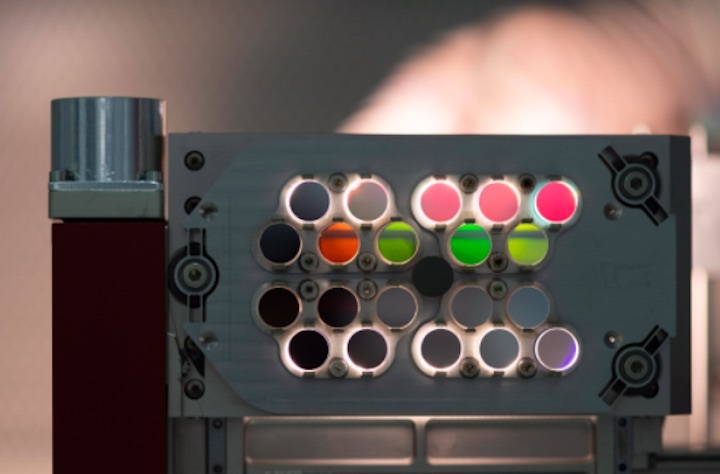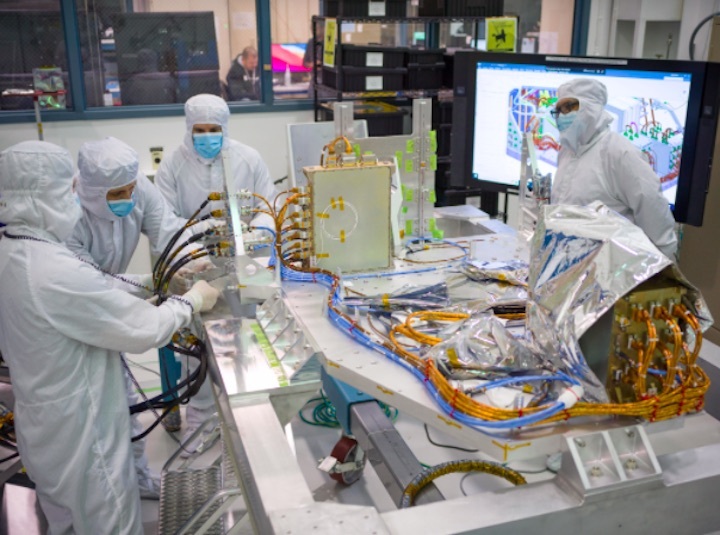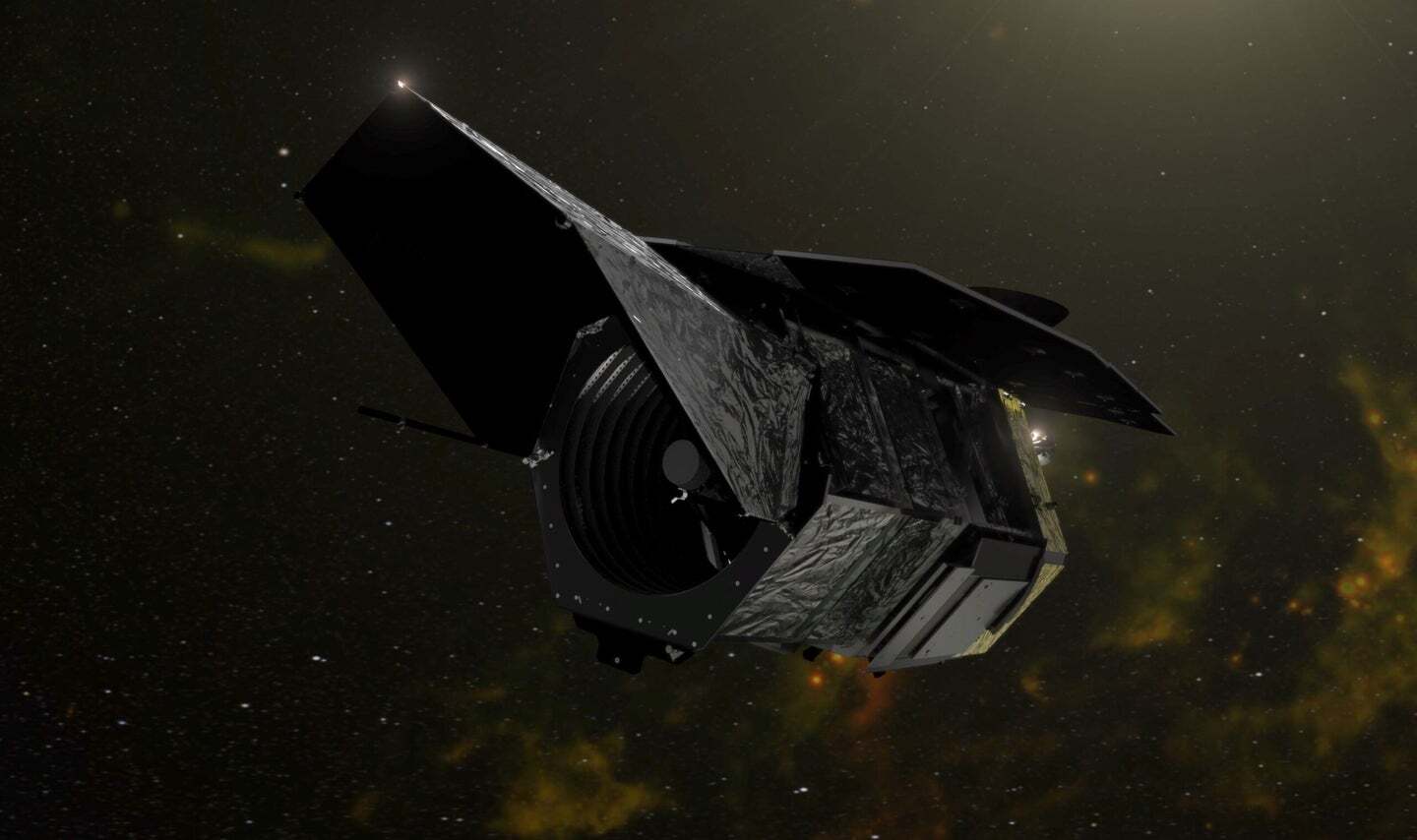23.12.2022
Assembly Begins on NASA’s Next Tool to Study Exoplanets

The filters on NASA's Roman Space Telescope Coronagraph Instrument's Color Filter Assembly each block all but a specific wavelength of light. Many of the filters appear dark in this photo because they are transparent only to infrared light. Credit: NASA/JPL-Caltech
The Coronagraph Instrument on NASA’s Nancy Grace Roman Space Telescope will study planets around other stars. Putting it together will require a highly choreographed dance.
Scientists have discovered more than 5,000 exoplanets, or planets outside our solar system. As technologies for studying these worlds continue to advance, researchers may someday be able to search for signs of life on exoplanets that are similar in size, composition, and temperature to Earth. But to do that they’ll need new tools, like those being tested on the Coronagraph Instrumenton NASA’s Nancy Grace Roman Space Telescope. The science instrument will block the light from each distant star it observes so that scientists can better see the planets around the star, and it will demonstrate technologies needed to eventually study potentially habitable planets with future missions.
The Coronagraph Instrument team has already designed the cutting-edge instrument and built the components. Now they have to put the pieces together and run tests to make sure they operate as intended. “It’s like all the separate tributaries are finally coming together to form the river,” said Jeff Oseas, product delivery manager for the Coronagraph Instrument’s optical subsystem at NASA’s Jet Propulsion Laboratory in Southern California.
The Coronagraph Instrument on NASA’s Roman Space Telescope is designed to block the light from a star and capture the much fainter light from orbiting planets. This video explains how the complex instrument works.
The process kicked off recently at JPL and will take more than a year. Once complete, the Coronagraph Instrument will be shipped to the agency’s Goddard Space Flight Center in Greenbelt, Maryland, and incorporated into the Roman observatory.
JPL engineer Gasia Bedrosian leads the assembly and testing process as the instrument’s integration and test product delivery manager. She likes to say that while integration and testing are technically the last steps in building an instrument, they’re actually part of the process from the beginning.
In 2018, Bedrosian started working on a set of assembly plans for something that’s never been built before. She and her team then spent another two years collaborating with various subject matter experts and project members to review and adjust the plan, ensuring all the pieces would come together on time and in the right order. The process will resemble a well-choreographed ballet that involves heavy duty cranes, lasers, and vacuum chambers the size of buses.

Roughly the size and shape of a baby grand piano, the Coronagraph Instrument is composed of two main sections that will stack on top of each another: the optical bench and the instrument electronics pallet.
The more delicate of the two is the optical bench, which contains 64 elements, such as mirrors and filters, designed to remove as much starlight as possible without suppressing the light from planets. This approach to finding and studying exoplanets is called direct imaging, and it is expected to be the best way to study the atmospheres and surface features of rocky worlds similar to Earth. Some of the optical components on the Coronagraph Instrument are so small they’re barely visible to the naked eye.
The pallet, or bottom layer, houses the electronics that receive instructions from the Roman spacecraft and return the Coronagraph Instrument’s scientific data. The electronics also control the mechanical components on the optical bench as well as the instrument heaters. The optical bench will be stacked by crane atop the electronics pallet. Because the two layers have to be aligned with each other to within a fraction of a millimeter, the team will use lasers to get them positioned just right over the course of four days.
Eye for Detail
Integration and testing teams will often use digital 3D models of the instrument to help make their plans, but nothing can compare to seeing the object in a real space. That’s why the coronagraph team made use of an augmented reality headset that lets users see a virtual projection of a 3D object and the world around them. The headset is also used by the Mars Curiosity rover team to see in 3D the Martian terrain that the rover drives over.
“We learned a lot from that exercise,” said Bedrosian. “We could get a sense of how tight the access would be at certain points of integration by literally laying on the floor and getting visuals of under the instrument. It showed us when it would be beneficial to lift the entire instrument with a crane, or if we were going to need a specialized tool to do our work at that angle. It helped make a lot of our plans safer and simpler.”
Once assembled, the Coronagraph Instrument will undergo a series of tests, including almost a month of dynamical testing to simulate the rocket ride into space. It will then be put in a vacuum chamber that replicates the space environment to check that the hardware remains aligned and operating correctly.
“It’s exciting to finally start putting all the pieces together,” said Bedrosian. “It’s definitely a delayed gratification, because we’ve spent so long preparing. But now that we’re here and my team members are talking about the hardware arriving, I can hear the excitement in their voices.”
More About the Mission
The Nancy Grace Roman Space Telescope is managed at NASA’s Goddard Space Flight Center in Greenbelt, Maryland, with participation by JPL and Caltech/IPAC in Southern California, the Space Telescope Science Institute in Baltimore, and a science team comprising scientists from various research institutions. The primary industrial partners are Ball Aerospace & Technologies Corp. in Boulder, Colorado; L3Harris Technologies in Melbourne, Florida; and Teledyne Scientific & Imaging in Thousand Oaks, California.
The Roman Coronagraph Instrument was designed and is being built at JPL, which manages the instrument for NASA. Contributions were made by ESA (the European Space Agency), the Japanese Aerospace Exploration Agency (JAXA), the French space agency Centre National d’Études Spatiales (CNES), and the Max Planck Institute for Astronomy (MPIA) in Germany. Caltech, in Pasadena, California, manages JPL for NASA.
Quelle: NASA
----
Update: 4.01.2023
.
The spy agency origins of NASA’s next powerful planet-hunting observatory
A Defense Department agency gifted NASA with mirrors to look for worlds beyond our solar system.

A former spy satellite is now being overhauled by NASA to search for planets beyond the solar system. Once operational—the space agency plans to launch the craft within the next five years—it could reveal the origins of life itself by hunting for planets in the distant reaches of their solar systems.
Now that the James Webb Space Telescope has finally launched and is in full science operation mode, the astronomical community is looking with eager anticipation to the next major launch, the Nancy Grace Roman Space Telescope. Among other directives, the Roman will be an exoplanet hunter extraordinaire, revealing key information about the formation of solar systems and planets like our own.
But, initially, it looked like the mission would never happen. In the early 2000s, scientists at NASA and the Department of Energy both proposed a new satellite to study the farthest reaches of the cosmos, hoping to understand the cause behind dark energy, the name given to the mysterious accelerated expansion of the universe. However, with political and financial capital shifting to the development of what would become the JWST, the proposal faltered.
And then in 2011 came an unexpected gift. The National Reconnaissance Office, the organization within the US government tasked with building and operating spy satellites for the NSA, CIA, and other three-letter agencies, apparently had some…extras. Sitting in a warehouse in upstate New York were two mirrors, similar to the one on the Hubble Space Telescope, that the NRO seemingly had no use for. The agency offered the mirrors to NASA free of charge.
To give you a sense of just how surreal this is, imagine all of the time, money, and engineering that went into designing and launching the JWST. Now imagine that a spy agency not only had two more JWST-class instruments, but didn’t even need them anymore.
Although the actual cost of the mirror represents only a relatively small fraction of the overall budget for a space mission like this, the unexpected gift galvanized support for the satellite, and the mission got its first official name: the Wide-Field Infrared Space Telescope, or WFIRST.
Now expected to launch in 2026 in 2027 (although likely later, as its development was already pushed back by the delays in getting the JWST to space), WFIRST has received its new monniker, in honor of the first female executive at NASA, Nancy Roman, who also served as the agency’s first Chief of Astronomy in the 1960s and 70s.
The Roman has the same size of mirror as the Hubble’s, but it will boast a much wider field of view. Equipped with a big enough camera, it can essentially act as “a hundred Hubbles” at a time. According to Scott Gaudi, a professor of astronomy at The Ohio State University and one of the leaders of the Roman mission, the team hopes to find around 1,500 exoplanets during its planned primary 5-year mission. However, it’s difficult to pin down the exact number, because figuring out how many planets orbit other stars is “exactly what Roman is trying to find out,” he says.
Among other science goals, one of the primary missions of the Roman Space Telescope will be to hunt down new populations of exoplanets using an innovative trick known as gravitational microlensing.
Microlensing is when “light from distant background stars is temporarily magnified when a planetary system passes close to our line of sight,” Gaudi says. Microlensing relies on sheer coincidence: While staring at one star, if another object passes through the line of sight to that star, that background light will briefly increase in brightness due to the bending of the light around the object.
The interloping object could be an entire planetary system, or it could be a wandering, “rogue” exoplanet, detached from any star. Astronomers know of only a couple dozen of these lost souls, but they estimate that our galaxy could be swarming with hundreds of billions of them. The Roman can find wandering exoplanets as small as Mars, and could potentially expand our catalog to a few hundred. That will give astronomers critical information as to how chaotic solar system formation is, which will help fine-tune models of the development of Earth-like planets.
Since the microlensing technique has trouble identifying planets orbiting close to their parent stars, the Roman Space Telescope won’t be able to pick out an Earth 2.0, though. Instead, it will focus on planets orbiting far away from their suns, analogous to the gas and ice giants of our solar system. Astronomers don’t know if our solar system, dominated by Jupiter and Saturn, is typical, or if ice giants like Neptune and Uranus are more common. Or maybe even something smaller: Unlike any other exoplanet-hunting telescope, the Roman will be able to detect planets as small as a few times the mass of the moon.
Creating the first-ever survey of planets orbiting far from their stars is crucial to understanding the origins of life on planets like Earth. “Since we think all of the water on Earth-like planets was delivered from the outer regions of planetary systems,” Gaudi says, ”by surveying these regions we can begin to understand how common potentially habitable planets are.”
If that weren’t enough, the Roman has one more planet-hunting trick up its sleeve. It will carry a coronagraph, a device that allows it to block out the light from nearby stars and directly image any exoplanets around it—a feat not even the JWST is capable of.
Taken altogether, Gaudi had a simple reaction to what he was most excited for with this upcoming super-telescope: “the unexpected!”
Quelle: Popular Science

